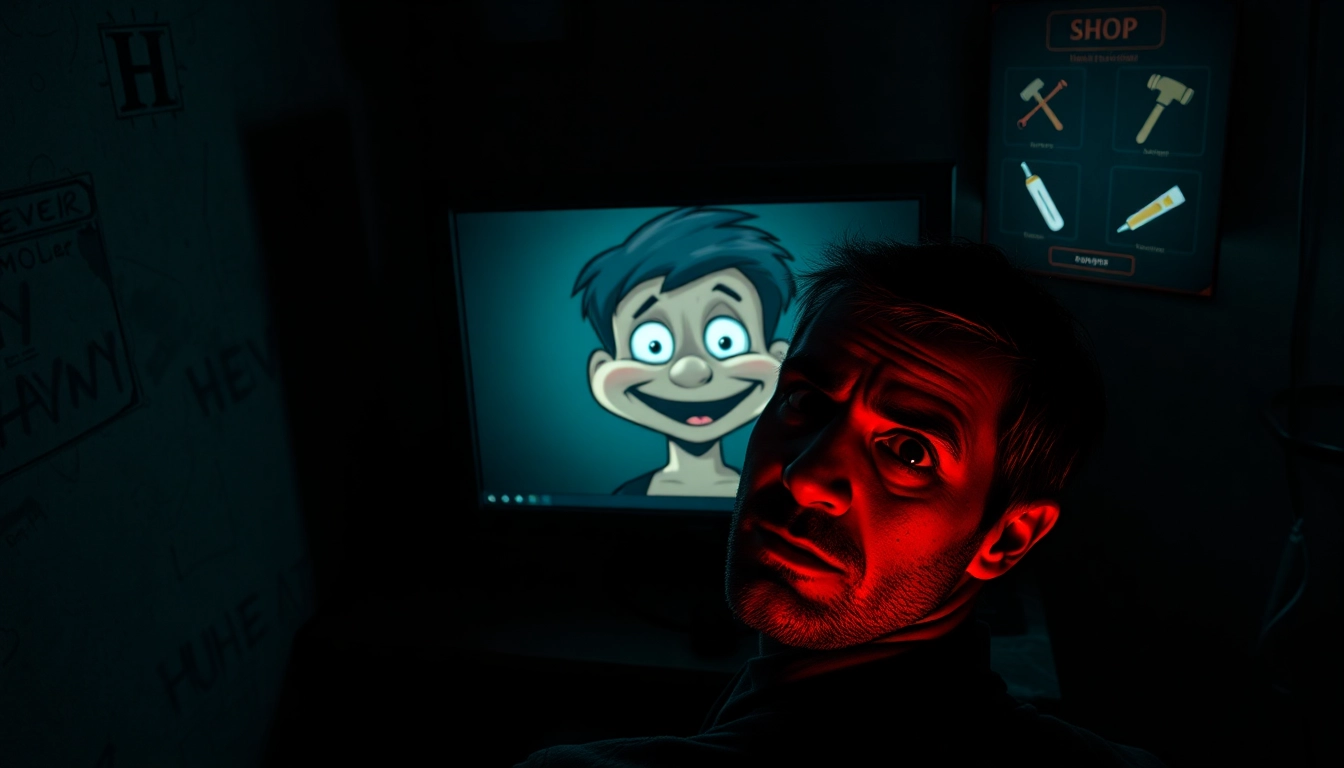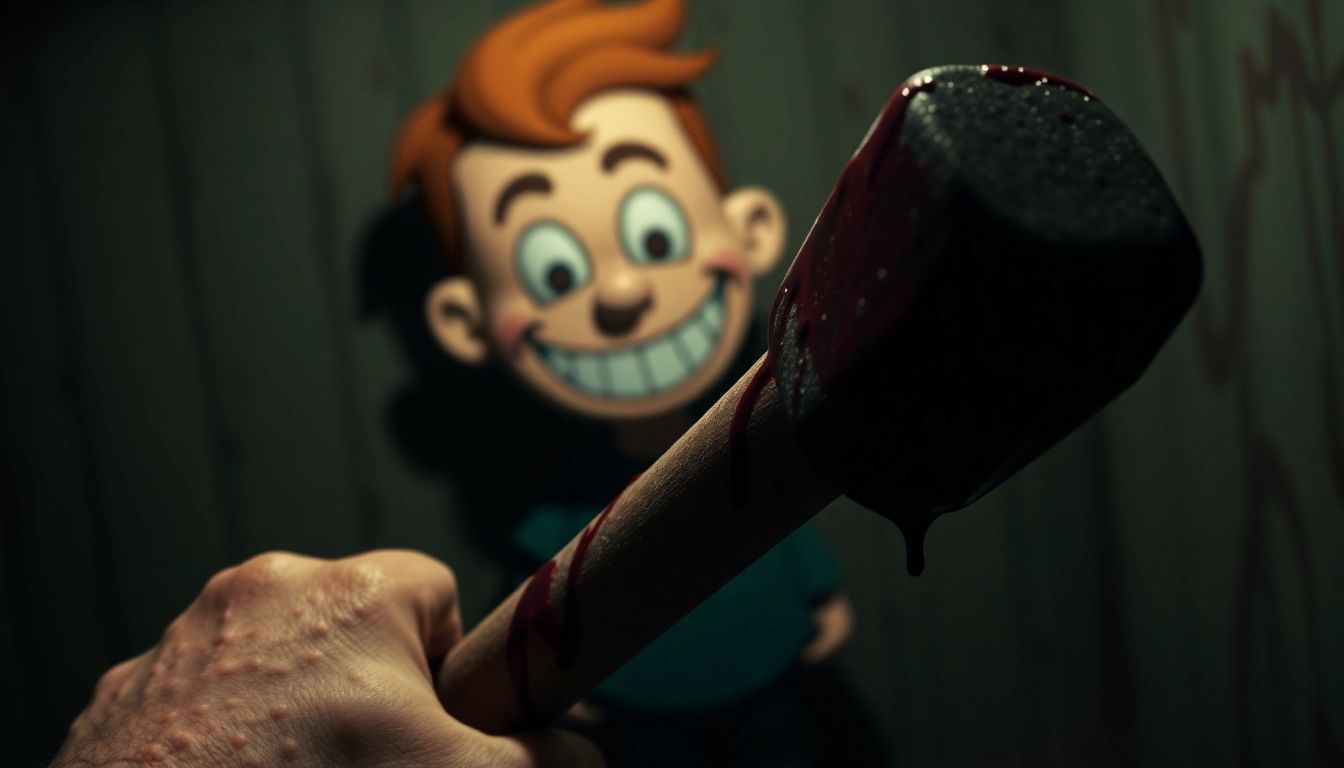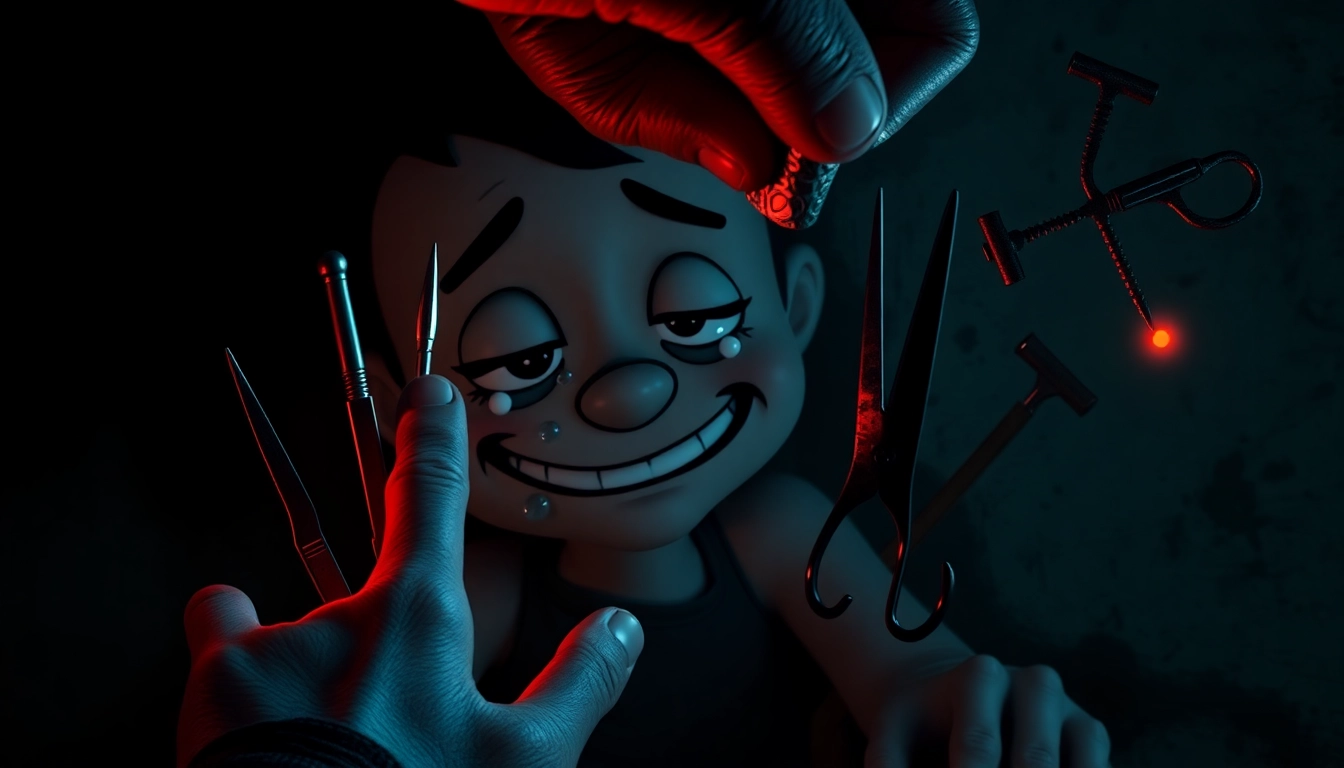Overview and Context of Bloodmoney: Dark Clicker Descent
Bloodmoney is a disturbing psychological horror clicker game that plunges players into a dark, morally complex universe where each interaction pushes the boundaries of human ethics. Developed to challenge notions of morality, empathy, and survival, Bloodmoney uniquely combines addictive gameplay mechanics with a haunting narrative. The game’s core premise revolves around a desperate individual diagnosed with a life-threatening condition needing $25,000 for treatment. Faced with limited options, the player encounters Harvey, an unsettlingly cheerful character who offers a twisted solution: click on him to generate money. But this seemingly simple mechanic masks a harrowing exploration of human depravity, as each click causes Harvey increasing pain and suffering, and unlocks progressively more violent tools in the shop system.
For those interested in experiencing this dark journey, bloodmoney invites players to confront their moral boundaries in an intensely psychological environment. The game’s mechanics are meticulously designed to evoke emotional responses, making the act of clicking not just a means to an end but a moral test—a reflection of how far one is willing to go to survive. As you delve deeper into Bloodmoney’s universe, the layers of narrative and gameplay intertwine, creating an experience that is as thought-provoking as it is unsettling.
The Dark Narrative of Bloodmoney and Its Engaging Gameplay Mechanics
Clicking Mechanics and the Drive for Profit
At the heart of Bloodmoney lies its simple yet profoundly impactful clicking mechanic. Every click on Harvey earns you money, which is desperately needed for medical bills. The tension is immediate: how quickly can you reach the $25,000 goal? Initially, the process appears innocent, almost humorous—Harvey’s cheerful demeanor contrasts sharply with the grim task at hand. However, as you continue clicking, Harvey’s reactions become increasingly distressed, and visual and auditory cues signal his rising pain. This duality between the cheerful character and the suffering he endures creates a visceral emotional experience, forcing players to reflect on the moral cost of their actions.
Upgrade System and Its Disturbing Implications
The game features an upgrade shop where players can purchase tools to boost earnings. These range from innocuous items like pillows for pillow fights to brutal weapons like needles, scissors, and hammers. Each purchase escalates Harvey’s suffering, but also enhances the click value, creating a twisted risk-reward dynamic. The more violent the tool, the faster and more profitably you can reach your goal—but at what moral and emotional expense? Observant players have noted subtle details suggesting Harvey might not fully understand the nature of the items, especially when surprised by more violent weapons, hinting at an underlying innocence or obliviousness. This adds a layer of moral complexity: is Harvey truly complicit, or is he unwittingly being exploited?
The Dark Narrative of Bloodmoney Game and Harvey
Harvey’s Character: Innocence in a Morally Corrupt World
Harvey embodies a paradox—an innocent, cheerful figure caught in a nightmarish scenario. His surprised reactions to violent tools suggest a lack of awareness or understanding, which complicates the moral landscape. Is Harvey a victim of darker forces controlling the shop, or is he a willing participant? His visual transformation throughout gameplay—from a bright, smiling face to one marked by fear and pain—mirrors the player’s moral descent. The game masterfully uses subtle visual cues and dialogue to evoke empathy and discomfort simultaneously, making Harvey a mirror for the player’s own moral choices.
Visual and Emotional Transformation
As players continue clicking and upgrading, Harvey’s appearance and reactions change markedly. His eyes grow wider with each violent interaction, his posture stiffens, and his expressions shift from cheerful to distressed. These visual cues serve as a powerful reminder of the human cost behind the profits. The game’s emotional design compels players to confront their own potential for cruelty, highlighting the duality of human nature in desperate circumstances.
Game Mechanics: Multiple Pathways and Their Moral Implications
Choosing Your Path: Minimal Harm, Moderate Violence, or Maximum Efficiency
Bloodmoney offers players multiple pathways to achieve their financial goal, each with distinct moral consequences. Opting for the minimal harm approach involves using less violent tools like scissors or needles, resulting in a more humane but slower path to the goal. Conversely, maximizing profits might involve purchasing the most violent tools, such as hammers or knives, causing Harvey significant pain and suffering. Interestingly, players have discovered that even with controversial tools like the hammer, it’s possible to attain the good ending, suggesting that gameplay choices and subtle decision-making influence outcomes more than raw brutality.
Time Pressure and Psychological Horror
The ticking clock adds a layer of tension, emphasizing the urgency of the medical bills. Time pressure forces players to make quick decisions, often leading to morally questionable choices. The game’s psychological horror elements are heightened by Harvey’s reactions—his distress, fear, and pain become a visceral experience. This design fosters a deep emotional connection, making the moral dilemmas more impactful and personal.
Community Insights and Player Reactions
Shared Experiences and Moral Reflections
The Bloodmoney community is vibrant, with players discussing their routes to various endings, moral reflections, and emotional reactions. Many players report feeling genuine guilt and discomfort, particularly when Harvey’s reactions become visibly distressed. Some have noted that the game’s subtle storytelling and visual cues encourage multiple playthroughs to explore different moral choices. Reddit and YouTube communities have become hotspots for sharing gameplay strategies, hidden secrets, and philosophical debates about the game’s underlying themes.
Notable Gameplay Videos and Analysis
Popular gameplay videos, such as those by content creators like SHROOMYCHRIST and GamerScott, showcase the game’s intense emotional impact. These videos often highlight the subtle differences in approach—using less violent tools versus more brutal ones—and how these choices influence the ending. The analysis reveals that Bloodmoney is not just a clicker game but a profound commentary on human morality, desperation, and the capacity for cruelty under pressure.
The Deeper Themes of Humanity and Morality in Bloodmoney
Testing Humanity in Desperate Situations
Bloodmoney is a mirror held up to the darker aspects of human nature. Harvey’s innocence juxtaposed with the violent tools and the player’s choices symbolize the internal struggle between compassion and greed. The game questions whether survival justifies moral compromise and explores how circumstances can distort our sense of right and wrong. The varying endings—Good, Normal, and Bad—serve as moral reflections on the player’s decisions, inviting introspection about the true cost of survival.
The Duality of Good and Evil
The game brilliantly captures the duality of human nature. Harvey represents innocence trying to help, whereas the shop appears controlled by darker forces, pushing players toward ethical decline. This dichotomy emphasizes that morality is often fluid and situational, especially when survival is at stake. Bloodmoney forces players to confront uncomfortable truths: Are we inherently good, or does adversity reveal our darker selves?
Psychological Horror and Emotional Impact
Visual Cues and Atmosphere
Bloodmoney excels in creating an unsettling atmosphere through subtle visual cues—Harvey’s changing expressions, the progressively violent tools, and the increasingly grim visuals. Dialogue and sound design further enhance the horror, evoking empathy and horror simultaneously. The emotional journey from guiltless clicking to moral turmoil is crafted with meticulous attention to detail, making the experience deeply personal and haunting.
Emotional Engagement and Player Reflection
Many players have reported feeling genuine emotional distress, especially when Harvey’s reactions to pain become visibly intense. This emotional engagement is the game’s strength, forcing players to reflect on their own values and limits. It raises questions about the ethics of profit, the nature of suffering, and the human capacity for cruelty—highlighting that sometimes, the most disturbing horrors are psychological rather than physical.
Multiple Endings: Your Choices Shape Your Fate
The Good Ending
The Good Ending is achievable when players prioritize minimizing Harvey’s suffering, even if it means taking longer to reach the financial goal. Using less violent tools like scissors or needles, and carefully balancing clicks and upgrades, results in a more humane resolution. Harvey survives with his dignity intact, and the moral weight of the journey remains lighter. This ending offers a glimmer of hope and moral integrity amid the darkness.
The Normal Ending
The Normal Ending is accessible through moderate choices—using tools like scissors or the needle, and balancing profit with some degree of violence. Harvey’s suffering is present but not excessive, and the ending reflects a compromise between morality and survival. It’s a more balanced conclusion that acknowledges the complexity of moral decisions in desperate circumstances.
The Bad Ending
The Bad Ending is reached when players maximize profit regardless of Harvey’s suffering, purchasing the most violent tools like hammers and knives. Harvey’s pain and fear reach their peak, and the game’s visuals become increasingly disturbing. This ending symbolizes moral decay, where the pursuit of profit overrides compassion and humanity. It’s a stark reminder of the potential darkness within us—especially when survival is on the line.
Community Insights and Hidden Details
Subtle Clues and Discoveries
Players have uncovered fascinating details suggesting Harvey may not fully understand the shop’s contents. His surprise reactions to violent tools imply innocence or ignorance, adding a layer of moral ambiguity. Some players speculate that Harvey is a puppet, manipulated by unseen forces, which raises questions about exploitation and consent. These subtle clues deepen the narrative, encouraging multiple playthroughs to explore different moral pathways.
Strategies for Achieving Endings
Effective strategies involve balancing clicking speed, upgrade choices, and moral considerations. For example, using the scissors or needle can still lead to the good ending, while the hammer can be used in a way that minimizes Harvey’s suffering if approached carefully. The game tracks player behavior subtly, rewarding nuanced decision-making over brute force. This layered gameplay encourages repeated engagement and philosophical reflection.
Thematic Analysis: Humanity, Morality, and the Nature of Survival
Bloodmoney serves as a profound allegory for human morality under duress. Harvey symbolizes innocence, hope, and the potential for kindness, while the shop and tools embody darker impulses—greed, violence, and exploitation. The game prompts players to question whether survival justifies moral compromise, and whether true morality is possible when pushed to the limit. The multiple endings serve as moral outcomes, reflecting the player’s choices and values.
Ultimately, Bloodmoney explores whether profit is worth the moral cost, and how desperation can distort our sense of right and wrong. It challenges us to consider our own boundaries and the societal implications of valuing profit over compassion. The game’s unsettling atmosphere and layered storytelling make it an unforgettable experience that lingers long after the screen goes dark.
Comparing Bloodmoney to Similar Psychological Horror Games
Bloodmoney shares thematic similarities with other psychological horror titles that explore morality, human nature, and the darker aspects of the mind. Games like “The Cat Lady,” “Silent Hill,” and “Hiveswap” delve into psychological trauma and moral ambiguity, but Bloodmoney distinguishes itself through its minimalist clicker mechanics and visceral moral dilemmas. Its focus on incremental decision-making and visual storytelling creates an intense, personal experience that resonates with players seeking more than just scares—offering a profound philosophical challenge.
Unlike traditional horror games that rely on jump scares or overt violence, Bloodmoney’s horror is psychological and moral, making it a unique addition to the genre. Its simplicity allows for deep introspection, turning a straightforward clicker game into a compelling moral allegory.
Final Thoughts: Is Profit Worth the Cost?
Bloodmoney is a haunting exploration of morality in extreme circumstances. It forces players to confront uncomfortable truths—how far are we willing to go when survival demands sacrifice? Every click, upgrade, and decision shapes Harvey’s fate and the ending you receive. The game’s strength lies in its emotional and moral complexity, using minimalistic mechanics to evoke profound reflection.
In the end, the question remains: is profit worth the moral cost? Bloodmoney doesn’t provide easy answers; instead, it challenges players to examine their own values and limits. Its unsettling atmosphere, layered storytelling, and moral dilemmas make it a must-play for those interested in psychological horror that tests the very fabric of human morality.
For a dark, thought-provoking experience that pushes ethical boundaries, dive into bloodmoney and see how far your conscience can go in the pursuit of survival.



